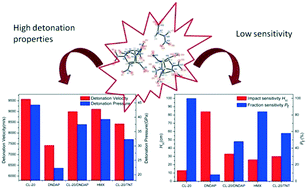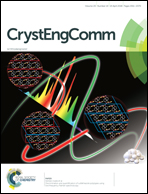Preparation of CL-20/DNDAP cocrystals by a rapid and continuous spray drying method: an alternative to cocrystal formation†
Abstract
Cocrystals of 2,4,6,8,10,12-hexanitrohexaazaisowurtzitane (CL-20) and 2,4-dinitro-2,4-diazapentane (DNDAP) in a 2 : 1 molar ratio were prepared by both slow evaporation and spray drying methods. The structure of the cocrystals was characterized using single crystal X-ray diffraction and it showed evidence of hydrogen bonds between HCL-20 and ODNDAP to the primary stabilizing force in cocrystal formation. Infrared spectroscopy and powder X-ray diffraction analysis indicated that the polycrystalline product from the spray drying method is consistent with the single crystals from solution crystallization. DSC and TG tests revealed that the exothermic decomposition of the cocrystal occurs via two main continuous steps with peak maxima at 223.5 °C and 254.1 °C and largely increases the melting point of DNDAP by 129.9 °C. The cocrystal possesses high detonation velocity and detonation pressure (8997 m s−1 and 37.5 GPa, respectively); meanwhile it features significantly reduced impact and friction sensitivities relative to those of CL-20. These results demonstrate that the CL-20/DNDAP cocrystal can be utilized as a promising ingredient in explosive applications.



 Please wait while we load your content...
Please wait while we load your content...